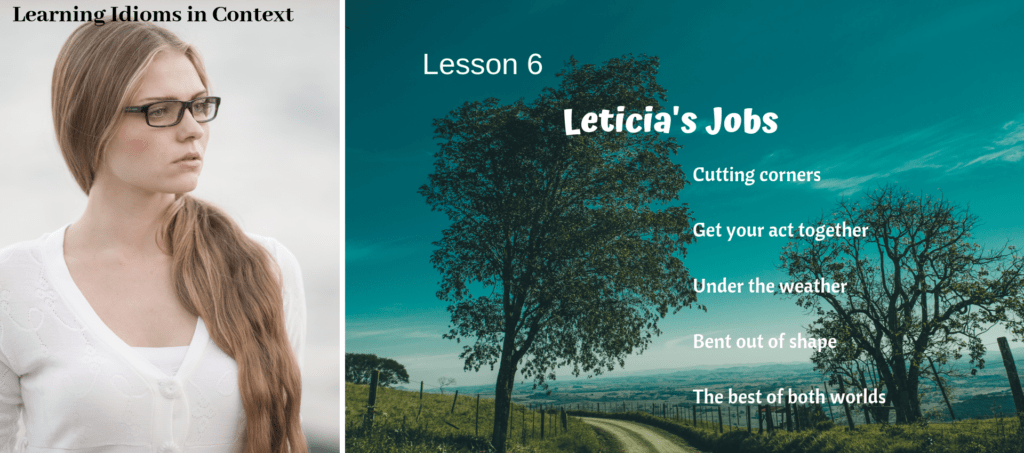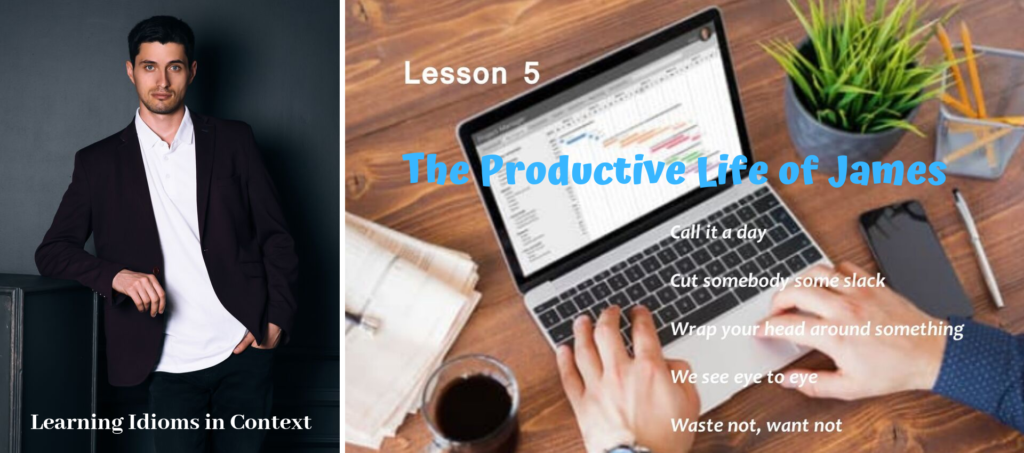Here is a story about a lady who has a different job each day. You’ll find idiom definitions, example sentences, conversations, and a short quiz after reading the story.
On Monday morning, Leticia’s mother sent her off to work in their nearby garden. Leticia was under the weather that day, but she still obeyed her mother. Leticia watered all the plants and did the task with a smile. As she crossed a path to the other side of the garden, she dropped the bucket.
When she told her about it, Leticia’s mother shook her head. “Be careful next time,” she advised. “You should learn how to hold a bucket properly. You should practice today and remember that tomorrow when you go again in our garden.”
On Tuesday morning, Leticia’s mother sent her off to work in a nearby grocery store. Leticia did her job well, so the grocery owner gave her a bonus for that day. Leticia remembered her mother’s words, went to the mall to reward herself. On her way home, she realized that she had spent all her money.
When she told her, Leticia’s mother shook her head. “Be wise next time,” she advised. “You should learn how to spend your money wisely, get your act together, and save some for your future.”
On Wednesday morning, Leticia’s mother sent her off to work in a park to offer volunteer work. Leticia did her job well, and the park manager gave her a beautiful white rabbit. Leticia remembered her mother’s words, so she decided to go home immediately without spending too much. But on her way home, the rabbit was frightened, jumped from Leticia’s basket into a nearby house, and never had the chance to find it.
When she told her, Leticia’s mother shook her head. “Be quick next time,” she advised. “You should learn how to move fast and run after things quickly. Never try to get bent out of shape if you cannot get what you want.”
On Thursday morning, Leticia’s mother sent her off to work in a bakery. Leticia did her job well, so the owner gave her a dog. Leticia remembered her mother’s words, so she decided not to get the dog because she was afraid that she might not have caught it when it will suddenly run.
When she told her, Leticia’s mother shook her head. “Be grateful next time,” she said. “You should learn how to recognize the significance of rearing a dog. I believe that having a dog gives you the best of both worlds. it can be your cuddly companion at the same time bring health benefits to you.”
On Friday morning, Leticia’s mother sent her off to the nearby garden again. Leticia was under the weather again, so it was evident that cutting corners was her strategy. Leticia watered the plants inefficiently. A few minutes later, she thought that some plants might die soon because of what she did. With this, she went back and watered all plants again. But as she crossed a path to the other side of the garden, she saw a cookbook, kept it, and went home. Leticia remembered all her mother’s words, and she got back home without dropping the book.
When she told her, Leticia’s mother didn’t shake her head. She hugged and kissed her daughter and said, “You don’t need to go to work anymore, and you don’t need to remember many things. Read this cookbook and stay with me.”
After a month of preparation, she became an excellent cook for her mom. Leticia’s knowledge paved the way to establishing a small restaurant. Leticia has remembered all her mother’s advised. A few years passed, her restaurant became one of the most famous restaurants in their area.
Cutting corners
Meaning
- to skip some specific steps or processes to make something easier to finish and this can harm the output
Example Sentences
Stop cutting corners when completing a project as it has to be undertaken efficiently, whatever the cost.
Leila secretly finishes her task too quickly by cutting corners, and this causes some problems in her output.
A: The accounting team was suspended due to some discrepancy issues found.
B: Yes, the team is under investigation. When the director finds out that they are cutting corners, I am sure they will be fired.
Get your act together
Meaning
- to work more efficiently or organize yourself and work well with defined goals
Example sentences
You must get your act together if you wanted to be the next leader of the research team.
The department head warned him to get his act together because he had a constant poor performance.
A: I heard our senior analyst had a hard time completing his weekly reports on time.
B: Yes, that is correct. Our manager warned him to get his act together. Hopefully, he can change for the better.
Under the weather
Meaning
- someone feels sick
Example Sentences
My daughter did not go to school yesterday because she was feeling under the weather.
After a long walk, Dana was feeling under the weather for the next few days.
A: I did not see Michael the whole day. What do you think has happened?
B: Michael has attended a whole night party, so now he is under the weather.
Bent out of shape
Meaning
- someone that is angry or annoyed
Example Sentences
You should talk to Jacky and apologize to her before she gets bent out of shape.
Carol has no right to bent out of shape to her sister as she intentionally harms her.
A: Our Math teacher has given us a very difficult quiz.
B: I think she did that because she was bent out of shape. Most of us were not paying attention during our Math class a few weeks ago.
The best of both worlds
Meaning
- a situation wherein you can benefit desirable traits of two different things
Example Sentences
Mae believes that residing in a university dorm offers her the best of both worlds: a place where she can both study and meet new friends.
My sister gets the best of both worlds because she always overeats but doesn’t get fat!
A: Hey, I have bought this bicycle for a very minimal amount. You will be surprised at its cost!
B: Don’t party yet! Most of the time, you can never have the best of both worlds when you buy an item that is so cheap, but the quality is not guaranteed.
Quiz
1. Some businesses were used to __________________ and this led them to bankruptcy after a few years.
2. Simon was warned to _________________ if he wanted to stay long in his current company.
3. Jake was a bit ____________________. With this, he decided to rest instead of going to the movies with his friends.
4. My father gets ____________________ when we pronounce his name incorrectly.
5. Brian has ____________________ because he lives in a small village but only two miles away from the city.



